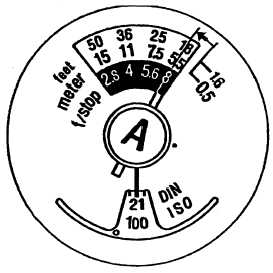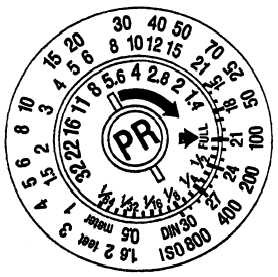Figure 11-15.—Exposure scale on a flash unit (automatic mode).
Figure 11-16.—Exposure scale on a flash unit (manual mode).
sunlight), the only consideration is the amount of light
reflected from the subject. The distance between the
camera and the subject has no bearing on exposure.
When the flash is used off the camera, the basic f/stop
is still calculated with the flash-to-subject distance.
Automatic Electronic Flash Units
Most electronic flash units can be operated in an
automatic exposure mode. An automatic flash unit
eliminates the need to determine the correct f/stop for
each flash-to-subject distance, providing the subject is
within the flash distance range of the flash.
On the front of an automatic flash unit, a sensor
reads the light reflected from the subject that is produced
by the flash. When this sensor is satisfied as to the
amount of light received, it automatically shuts off the
flash. The closer the subject is to the lamp, the quicker
the sensor shuts off the light.
Some automatic electronic flash units allow you to
select two or more apertures to control depth of field. To
determine an f/stop in the automatic mode, you can use
the calculator dial located on the unit. When you match
the indicator to an ISO film speed number on the dial
(fig. 11-15), the f/stop to be used within a minimum and
maximum distance is indicated. Once an f/stop is
selected and set, it is a constant factor regardless of the
flash-to-subject distance, providing it is within the flash
distance range of the unit. This feature allows a
photographer to move closer to or further away from the
subject without having to calculate an f/stop for each
change of flash-to-subject distance.
When the flash unit is in the manual mode, the f/stop
must be changed every time the flash-to-subject
distance changes. A scale on the flash unit (fig. 11-16)
indicates the proper f/stop to use for the various
distances. To determine the flash-to-subject distance for
on-camera flash, focus on the subject and read the
distance directly from the focusing ring on the camera.
Single Flash
You will produce the majority of your indoor
photographs with a single flash unit. Numerous
reenlistments, frocking and promotion ceremonies are
conducted indoors where the lighting conditions are
unfavorable for available light photography. There are
various methods in which a single flash can be used to
produce high-quality professional photographs which
distinguish you from the amateur snapshooter.
On-Camera Flash
A flash technique commonly used is that of the flash
unit attached to the camera, in synchronization with the
shutter, and aimed directly at a subject. An advantage of
having your flash unit attached to the camera is it gives
you the chance to capture the unexpected — the truly
candid shot. When spontaneity sparks the action and
quick camera handling is a must, the fewer pieces of
equipment you have to worry about or handle, the better.
Rather than two pieces of gear (the camera and the
flash), you have only one — the camera with the flash
attached to it. However, this technique usually produces
objectionable shadows behind the subject.
11-15



